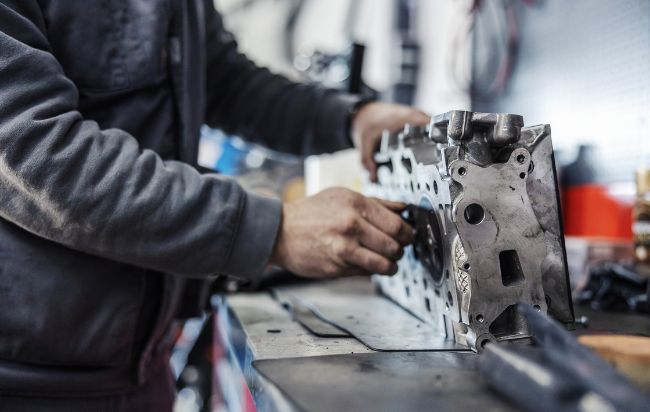
Several components make up your engine and influence its performance. The cylinder head connects the intake valve to the exhaust manifold to assist with the combustion process – specifically, moving the air and fuel mixture to the pistons. Within this relationship, air and fuel ignite in the cylinder and the exhaust manifold directs any gases to the exhaust system. Along with this process, the head simultaneously compresses the cylinder below.
What Is the Cylinder Head?
Considering the complexities of the combustion process, damage to the cylinder and cylinder head ultimately affects your car’s performance and fuel usage. Here’s what you should know.
The cylinder head is connected to the engine block, sitting toward the top of the engine and helping to control the combustion chamber. They contain a series of valves that divert air and the gases generated.
Intake valves bring in fresh air, while exhaust valves let the air and fuel mixture leave the combustion chamber. As this occurs, proper lubrication helps control temperature and movement, allowing the pistons to move and the valves in the head to open and close during the combustion process. Yet through wear, overheating or impact, the cylinder head can crack.
In terms of maintenance timelines, a typical cylinder head lasts about five years, although materials can vary. Cast iron tends to show cracks sooner than aluminum. Multiple factors can cause a crack to form:
- Overheating, often related to low or leaking coolant or a damaged gasket.
- Warping, more likely to affect aluminum and directly resulting from heat.
Why Do Cylinder Heads Crack?
Repeat heating from combustion can cause the valves to harden or become stiff. This development places more stress on the cylinder head, eventually resulting in a crack caused by one of these factors:
- An overheating engine: A facet involved in the cooling system begins to malfunction, causing the engine to routinely overheat. These higher temperatures can heat and place stress on the aluminum and valves, resulting in cracks.
- A coolant leak: An engine low on coolant from a leak is more likely to overheat. In general, a cracked cylinder, damaged gaskets and a cracked engine block can indicate a leak somewhere in the cooling system.
- Air in the cooling system: Air that enters your car’s cooling system can cause hot spots to form in the engine. In these areas, the cooling system doesn’t remove heat as effectively. Temperature sensors don’t always pick up on this condition, which can place stress on the cylinder head.
- Water pump failure: When a water pump fails, coolant does not properly circulate through the engine, causing parts like the cylinder head to heat up, warp and crack.
- Defective thermostat: When the thermostat doesn’t accurately detect engine temperature, coolant doesn’t circulate and the engine begins to overheat, affecting its parts.
A few signs point to a cracked cylinder head in relation to these issues:
- An oil leak
- The oil light turns on, indicating decreased pressure
- A coolant leak, indicated by your dashboard or pooling underneath the engine. However, coolant leaks can sometimes by diverted to the combustion chamber or oil reserve.
- Decreased engine performance, including power loss or a delay when you attempt to accelerate.
- A smoking engine, which indicates coolant has leaked into the combustion chamber.
- Misfiring, which signals an issue with the air and fuel mixture.
Ignoring these issues can eventually lead to engine failure.
Cylinder Head Repairs
Never attempt to repair or replace a damaged cylinder head yourself. As this damage can indicate a greater problem with your engine’s performance and combustion process, take the vehicle in for an assessment – likely more than the cylinder head will need to be repaired.
A warped cylinder head may simply need to be resurfaced or realigned but typically, the part is replaced once a crack starts to show. Since the cylinder head is difficult to access, more labor may be involved, depending on your car’s year and model.
If you’ve noticed any of these warning signs, contact our Naugatuck shop to schedule a diagnostic appointment today.

